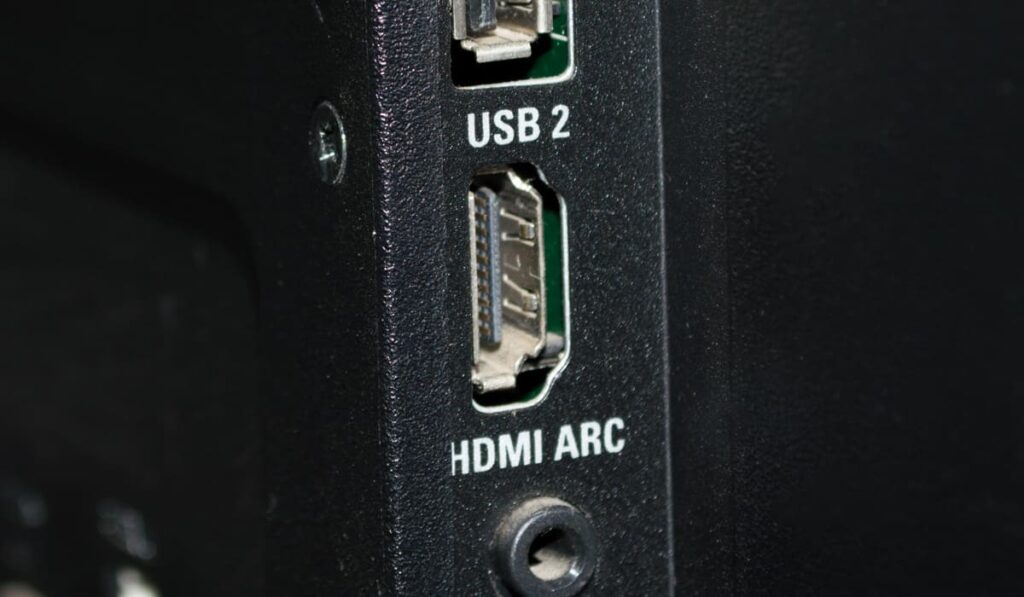Over the past few years, nearly every soundbar on the market has been switching to HDMI for audio transmission. Other options such as digital optical, AUX, and Bluetooth have quickly been outweighed by HDMI capabilities. With that being true, setting up and connecting HDMI is easier than you might think.
If both your TV and soundbar have HDMI ARC ports, then connect one end of the HDMI cable to the TV’s HDMI ARC port, then the other end into the soundbar’s HDMI ARC port. IF both devices don’t have HDMI ARC ports, then you’ll have to use a different type of cable to connect the two.
Sometimes, you may find that HDMI is not the best way to get your TV to recognize a soundbar. In that case, other options like digital optical may be the best option.
What is the Difference Between HDMI and HDMI ARC/eARC?

The primary difference between HDMI and HDMI ARC (Audio Return Channel) is the ability to send audio in the reverse direction to a soundbar or audio/video receiver. HDMI ARC also reduces the number of remote controllers and cables needed which allow the TV and soundbar to communicate with one another via HDMI CEC.
HDMI cables typically send video and audio signals in a single direction. Here's a quick example:
If you have a Fire TV Stick, Blu-ray player, or gaming console. Without ARC, these media devices would have to connect directly to the soundbar or an A/V receiver via HDMI. Then you would connect an HDMI cable from the soundbar's HDMI output to any of the TV's HDMI inputs.
The issue with this scenario is that any devices connected directly to the TV or even the TV's smart apps have no way to send the audio signal to the soundbar. HDMI ARC/eARC solves this problem where audio can basically travel “backwards” through an HDMI cable to a connected soundbar or audio/video receiver.
If your TV has an HDMI ARC port, the soundbar will also need an HDMI ARC port to connect properly. In other words, it’s a good idea to see what kind of port your TV already has before buying the soundbar or HDMI cable.
How Can I Tell If My TV Has ARC Or eARC?

It is generally very simple to tell if a TV has ARC/eARC or not. All you need to do is look at the labels next to the HDMI ports. You'll see numbers to indicate which input number that HDMI port is, and one of the HDMI ports will have ARC, eARC, or ARC/eARC labeled next to it.
You should look at all of the HDMI ports and see if any of them are labeled HDMI ARC or HDMI eARC. If you find one that has either of these, you will be able to configure your soundbar and TV using such.
Why Is My HDMI Cable Not Working?
If you arent getting any results after connecting your soundbar with an HDMI cable, there are a few things you can do to troubleshoot this issue.
- Double-check to make sure the cable is connected to the correct HDMI port. If both ends are connected properly, disconnect both ends of the HDMI cable, power off each device, reconnect the HDMI cable to both devices, and power both devices back on.
- Ensure that HDMI CEC is enabled on your TV. This is typically located in the system settings or audio settings.
- Check for any damages, pinches, or kinks in the cable. This could be a sign that the HDMI cable is internally damaged and it’s time for a new one.
- If the issue continues, check for firmware updates on both devices and ensure that all of the settings on both the soundbar and the TV are set properly (Sometimes the soundbar can be set to a different input, so be sure it’s set to the HDMI ARC or TV input).
What if the TV Doesn't Have an HDMI ARC Port?
If your TV doesn't have an HDMI ARC port, but your soundbar does, then you'll need to connect the TV and soundbar with a different cable. The more common options are Digital Optical and AUX/RCA. Unfortunately, these options don't provide the best audio quality, but will work perfectly fine with most low-end and mid-tier soundbars.
A majority of TV's will have either a digital optical (S/PDIF) output, a 3.5mm AUX output, and sometimes both. Make sure that your soundbar also has one of these inputs available, but it's very unlikely that it doesn't have at least one of these. Digital Optical inputs are more common than AUX inputs by the way.
Once you've identified the correct input and output on both devices, simply connect the digital optical or AUX cable and it should automatically start working.
Note: You may need to set the audio output on the TV which is typically located in the sound/audio settings.
Connecting a Soundbar With HDMI is Easier Than You Thought
Setting a soundbar up should not be impossible; it should be straightforward and relatively simple.
You will want to ensure that you have the proper HDMI cable connecting from one piece of equipment to the next. Remember to look behind your TV at each port to see what kind of cable is required to connect everything together.
You will see clear labels to help you identify what cable to buy. Very shortly you will have an enjoyable experience with your soundbar once you figure out how to set it up for the best results.





